Midrange CPU Roundup: It's Time to Buy
by Anand Lal Shimpi on September 28, 2007 2:00 AM EST- Posted in
- CPUs
How Cheap Can You Go? AMD Chipset Comparison
When looking at AMD chipsets you'll notice that we chose a different benchmark; instead of SYSMark 2007 we used PC WorldBench 6 - the reason being that none of the NVIDIA GeForce 6xxx series chipsets could complete a single SYSmark run. The new AMD 690 chipsets and the GeForce 7050 had no problem, but the older 6xxx chipsets were too finicky.
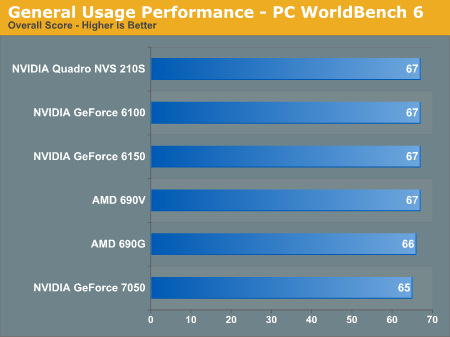
Performance wise, there's really not much to see on the AMD side of things. All of the chipsets are within a two point spread, and figuring margin of error at one point we can basically call this as close to a tie as we're likely to get. Honestly, other than the VIA chipsets, we had the most problems with NVIDIA GeForce 6xxx based motherboards. They all seem to be extremely picky about component choices, especially when it came to memory and power supply selection.
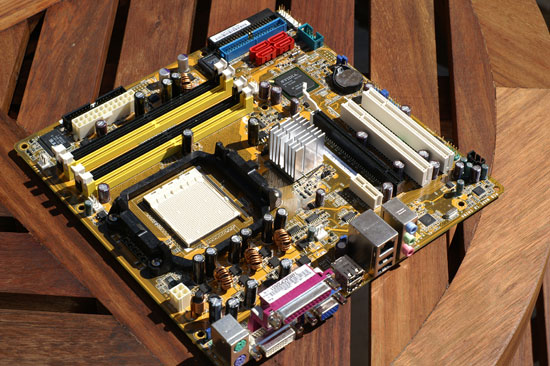
A finicky motherboard, stay away from the GeForce 6000 series boards.
We ran into one problem where our GeForce 6150 motherboard wouldn't POST without a PCI Express graphics card installed unless we switched power supplies. Memory selection is also critical for ensuring proper operation, and these motherboards are very picky about what they will and won't work with. We'd strongly suggest consulting approved memory devices/vendors if you do end up going with any GeForce 6xxx based motherboards, or better yet, opt for something based on the AMD 690 or NVIDIA GeForce 7xxx chipsets.
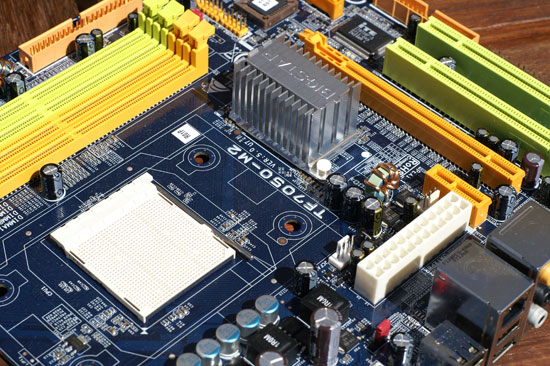
Biostar was the first company to send us a GeForce 7050 based motherboard and it worked flawlessly.
Although we tested them, we couldn't provide any performance results for any of the VIA chipsets currently offered for either AMD or Intel. Not only is Vista horrendously unstable with Aero enabled on any of VIA's integrated graphics platforms, but even with Aero off we couldn't get any of our performance suites to complete.
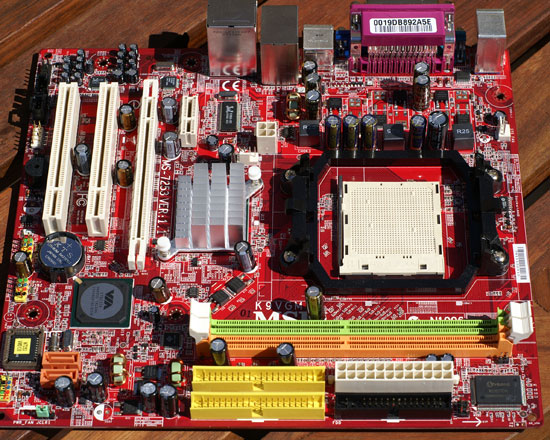
Stay away from VIA, there are simply far better options these days.
Manufacturers always ask why people have such good experiences with Intel's integrated chipsets, despite the fact that they have the worst graphics performance out of the lot. In our experience testing these platforms over the past couple of months, the Intel platforms always just worked and honestly it hasn't been until fairly recently that AMD has been able to say the same. AMD's 690G and 690V chipsets were just as seamless to install and set up as Intel's. The same can be said about NVIDIA's 7xxx series, so if you're going AMD we'd suggest picking from those three and staying away from the rest.
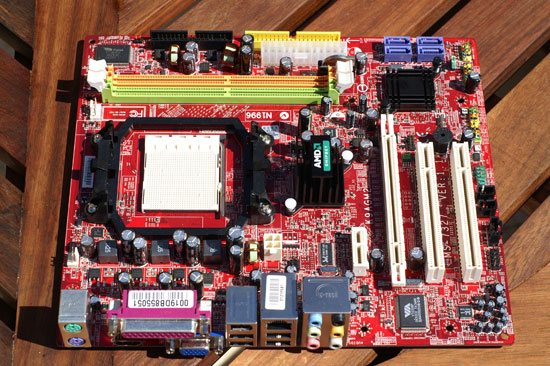
Our only real complaint about the 690G/690V is the driver bundle; there are far too many non-driver items that get installed by default. While not as bad as default spyware, when we download a chipset driver we don't expect to have to uncheck options for free games or Earthsim. Take a look around AMD; drivers shouldn't be bundled with this sort of stuff.
NVIDIA isn't totally off the hook either, as finding drivers for its 7xxx series of chipsets is impossible on the website. We had to download the nForce drivers for the 680a chipset and then GeForce 7 graphics drivers separately. What happened to the days of clean, single file unified drivers for everything NVIDIA? Perception is everything, and NVIDIA has done a lot of regressing with the perceived quality of its drivers as of late. In fact, it's only very recently that NVIDIA's graphics drivers - often considered the gold standard - reached the point where performance and features under Vista are up to snuff.
When looking at AMD chipsets you'll notice that we chose a different benchmark; instead of SYSMark 2007 we used PC WorldBench 6 - the reason being that none of the NVIDIA GeForce 6xxx series chipsets could complete a single SYSmark run. The new AMD 690 chipsets and the GeForce 7050 had no problem, but the older 6xxx chipsets were too finicky.

Performance wise, there's really not much to see on the AMD side of things. All of the chipsets are within a two point spread, and figuring margin of error at one point we can basically call this as close to a tie as we're likely to get. Honestly, other than the VIA chipsets, we had the most problems with NVIDIA GeForce 6xxx based motherboards. They all seem to be extremely picky about component choices, especially when it came to memory and power supply selection.

A finicky motherboard, stay away from the GeForce 6000 series boards.
We ran into one problem where our GeForce 6150 motherboard wouldn't POST without a PCI Express graphics card installed unless we switched power supplies. Memory selection is also critical for ensuring proper operation, and these motherboards are very picky about what they will and won't work with. We'd strongly suggest consulting approved memory devices/vendors if you do end up going with any GeForce 6xxx based motherboards, or better yet, opt for something based on the AMD 690 or NVIDIA GeForce 7xxx chipsets.

Biostar was the first company to send us a GeForce 7050 based motherboard and it worked flawlessly.
Although we tested them, we couldn't provide any performance results for any of the VIA chipsets currently offered for either AMD or Intel. Not only is Vista horrendously unstable with Aero enabled on any of VIA's integrated graphics platforms, but even with Aero off we couldn't get any of our performance suites to complete.

Stay away from VIA, there are simply far better options these days.
Manufacturers always ask why people have such good experiences with Intel's integrated chipsets, despite the fact that they have the worst graphics performance out of the lot. In our experience testing these platforms over the past couple of months, the Intel platforms always just worked and honestly it hasn't been until fairly recently that AMD has been able to say the same. AMD's 690G and 690V chipsets were just as seamless to install and set up as Intel's. The same can be said about NVIDIA's 7xxx series, so if you're going AMD we'd suggest picking from those three and staying away from the rest.

Our only real complaint about the 690G/690V is the driver bundle; there are far too many non-driver items that get installed by default. While not as bad as default spyware, when we download a chipset driver we don't expect to have to uncheck options for free games or Earthsim. Take a look around AMD; drivers shouldn't be bundled with this sort of stuff.
NVIDIA isn't totally off the hook either, as finding drivers for its 7xxx series of chipsets is impossible on the website. We had to download the nForce drivers for the 680a chipset and then GeForce 7 graphics drivers separately. What happened to the days of clean, single file unified drivers for everything NVIDIA? Perception is everything, and NVIDIA has done a lot of regressing with the perceived quality of its drivers as of late. In fact, it's only very recently that NVIDIA's graphics drivers - often considered the gold standard - reached the point where performance and features under Vista are up to snuff.










44 Comments
View All Comments
jonp - Sunday, September 30, 2007 - link
I too wonder about the Netburst admonition. There are probably millions of Netburst CPUs out there that are happily computing away with no thought of Anandtech at all; doing their thing; producing great results for their owners. The biggest concern I have seen is thermal and that, only in relation to overclocking. Assuming there are more than a few users that don't need to or want to overclock; then there are some great bargins in used Netburst Processors and accompanying motherboards.It doesn't appear to me that "...if you know what's best for you." is either technical, professional or helpful. Maybe it was meant as a joke...sorry it's not that funny.
HotdogIT - Friday, September 28, 2007 - link
Yes, you did. Given the combination of power usage savings, pure performance benefits, and overclocking ability (since you mentioned 3.6ghz on the Pentium D, I assume we can go with at least 2.4 out of an e2140, for comparisons sake), the C2D/Pentium E line is much better.
The problem with a lot of the "lol Pentium D overclocking" articles is they fail to overclock what they're comparing against. You take a Pentium D 805 and OC it to 4ghz, sure, the performance delta over an e2140 will be big. But apply the same cooling and thought into OCing the e2140, and that delta will swing the other way.
ThatLukeGuy - Saturday, September 29, 2007 - link
So what would make the most sense to change out the Pentium D805 to that would keep me at (or better yet raise the bar of) the performance I'm getting now? An OC'd e2140 or something higher up the ladder? I'm matching this to a 2gigs ram, an nice MSI SLI plat mobo, and an 8800gts320mb. I'd want something that wouldn't bottleneck the system which is what the P.D805 did when it was stock.
HotdogIT - Sunday, September 30, 2007 - link
It's going to depend on a lot of factors. If you're gaming, a change in the CPU may very well do very little in changing any performance; especially at a higher resolution, the CPU may make NO difference.
I'd look into the e2140/e2160/e4X00 line, if you wanted to stay lower cost. At the VERY least, you'll get a boost in energy efficency: The Pentium Ds were and are power hogs, especially compared to the newer line.
What performance did you see increase when you overclocked the Pentium D? Did gaming increase? If so, then a C2D based system would be much better, regardless of an overclock; Netburst just don't handle the games as well.
If, somehow, you're running something that is AMAZINGLY well tuned for Netburst, you may see less of an increase. But these applications are rare these days, so I doubt you'd see that in most cases.
Parhelion69 - Friday, September 28, 2007 - link
Anand did you do the power consumption tests on the overclocked cpus? I think it's important to know, if you haven't, can't you at least give us a rought estimation? It'd be greatly appreciated. Thanks.dm0r - Friday, September 28, 2007 - link
Thats a great article Anand, I missed this kind of roundup.Enjoyed a lot and the only thing is missing is the performance per watt, but anyway very good article.Thanks for sharing!eetnoyer - Friday, September 28, 2007 - link
Why not throw in the 4200+? I know it's 90nm, but I just got one for $74, and (for me)it looks like the sweet spot of price/performance for AMD. And, given how well tuned their 90nm process is at EOL, I wouldn't be surprised to see power consumption close to that of the 65nm chips. If you want, you could use the 65W version (it's only a buck more).Uter - Friday, September 28, 2007 - link
Anand, is the BE-2400 still coming out? Or, when you say that there are two Athlon X2 BE Processors, the BE-2350 and BE-2300, is that a subtle hint that we shouldn't expect to see it? I just want to make sure I pick one of these up while there are still available...bogda - Friday, September 28, 2007 - link
Oveclocking results are not fair. You chose horrible motherboards for AMD overclocking.For example, Biostar AMD motherboards cost 50-60 euros. They are much better overclockers than MSI or ASUS you chose. My Athlon BE-2300 easily overclocks from default 1,9GHz to over 2,8GHz with stock HSF.
wdb1966 - Sunday, September 30, 2007 - link
I completely agree, the boards chosen for the AMD chips are horrible.Gigabyte's MA69GM-S2H and Abit's NF-M2 nView would have been far superior choices in every way...poor motherboard choices, very poor.